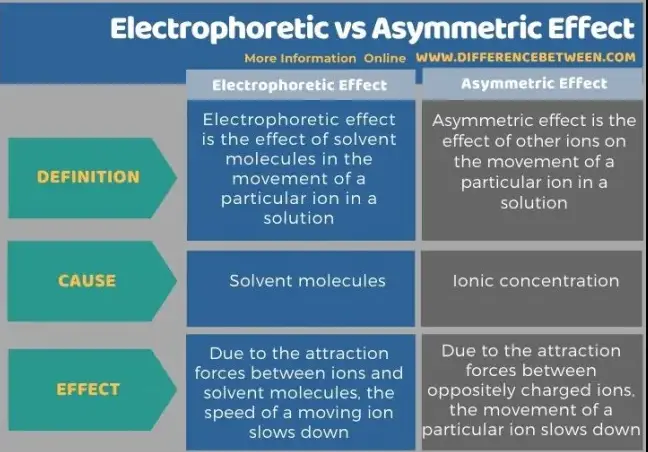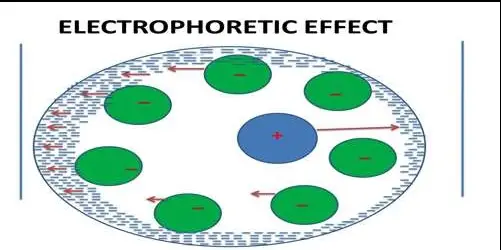The fields of science and technology are replete with various phenomena that influence modern innovations, among which the electrophoretic and asymmetric effects stand out due to their distinct properties and applications. While both play critical roles in several scientific applications, they are fundamentally different in their mechanisms and effects. This article sheds light on these differences, offering insights into each phenomenon’s unique aspects.
Electrophoretic effects occur when charged particles move under the influence of an electric field, commonly used in DNA sequencing and protein sorting. Conversely, the asymmetric effect refers to the occurrence where properties differ when measured in opposite directions in certain materials, crucial for devices like diodes and transistors. This inherent distinction highlights their varying applications and impacts in scientific research and technological development.
Both phenomena have paved the way for advancements in numerous fields, such as biotechnology and electronics. Understanding these effects not only enhances academic knowledge but also fosters innovation in developing new technologies and improving existing ones. Through a deeper exploration of their principles and applications, one can appreciate how they shape our technological landscape.

Electrophoretic Effect Basics
Definition and Principles
The electrophoretic effect is a physical phenomenon where charged particles suspended in a fluid move under the influence of a uniform electric field. This movement is based on the charge and size of the particles, allowing for a variety of applications in scientific and industrial settings. The underlying principle is that particles with a positive charge move towards the negative electrode, while those with a negative charge move towards the positive electrode. The speed of their movement is determined by their charge density and the viscosity of the fluid.
Applications in Industry
The electrophoretic effect has diverse applications across multiple industries. Here are a few key uses:
- Biotechnology: In DNA sequencing, this effect separates DNA fragments by size, enabling researchers to determine the sequence of bases in DNA.
- Pharmaceuticals: It aids in the analysis of proteins and other macromolecules, crucial for drug development and quality control.
- Environmental Science: Used in the analysis of soil and water samples to detect contamination by different substances.
- Food Industry: Helps in the quality control processes by separating and analyzing food components, such as proteins and additives.
Asymmetric Effect Basics
Definition and Principles
The asymmetric effect involves the variation in physical properties of materials when measured in different directions. This anisotropy can be observed in various material properties, including electrical, optical, and mechanical. For instance, an electric current may flow more easily in one direction than in the perpendicular direction in certain materials, which is crucial for the design of electronic components like diodes and transistors.
Applications in Technology
Asymmetric effects are vital in the development of technologies such as:
- Electronics: They are used in the manufacturing of rectifiers and capacitors, where directionality enhances device efficiency.
- Optoelectronics: Important in the design of lasers and other light-emitting devices where directional properties influence performance.
- Telecommunications: Enhances fiber optic technologies by improving the directionality of signal transmission.
Key Differences
Physical Properties
The primary difference between the electrophoretic and asymmetric effects lies in their physical properties. The electrophoretic effect is characterized by the mobility of ions and their response to electric fields, primarily used for separation techniques. Conversely, the asymmetric effect relates to the directional properties of materials, affecting how these materials interact with electrical and mechanical forces.
Functional Impact
The functional impact of these differences is significant in various applications:
- Electrophoretic Effect: Enhances precision in molecular biology experiments and industrial separation processes.
- Asymmetric Effect: Crucial for the functionality of electronic devices, impacting everything from consumer electronics to advanced computing systems.
Scientific Principles
Physics behind Electrophoretic Effect
The physics of the electrophoretic effect is grounded in electrokinetics, where electrically charged particles are influenced by an electric field. The movement is governed by factors such as the strength of the electric field, the type of fluid, and the size and charge of the particles. This effect exploits the properties of colloids and other suspensions to manipulate and separate particles effectively.
Chemistry of Asymmetric Effect
The chemistry behind the asymmetric effect often involves crystallography and molecular orientation. Materials exhibiting this effect have molecules that are structured in a way that their electrical or physical properties differ along various axes. This structural directionality can be exploited to create materials with unique optical, electrical, and mechanical properties, which are essential for several technological applications.

Technological Applications
Use in Medical Diagnostics
The electrophoretic effect has revolutionized medical diagnostics through its ability to separate biological molecules efficiently. Key applications include:
- Disease Diagnosis: By separating blood or DNA samples, doctors can diagnose diseases such as genetic disorders and infections more accurately.
- Protein Analysis: Proteins separated using this effect can be analyzed to understand disease mechanisms, leading to more targeted treatments.
- Drug Testing: Electrophoresis helps in testing the purity and properties of pharmaceuticals, ensuring safety and efficacy.
The asymmetric effect also contributes significantly to medical diagnostics, particularly in imaging technologies. The directional properties of certain materials improve the clarity and accuracy of images, essential for diagnosing conditions like cancer and heart disease.
Role in Material Science
Material science benefits greatly from both the electrophoretic and asymmetric effects. These impacts include:
- Development of New Materials: Understanding these effects allows scientists to create materials with specific, desirable properties, such as increased strength or conductivity.
- Enhanced Manufacturing Processes: The ability to control the deposition of materials at a microscopic level leads to more efficient manufacturing of complex structures.
Challenges and Solutions
Common Challenges with Electrophoretic Effect
Handling the electrophoretic effect comes with several challenges:
- Sample Loss: Small samples can adhere to the sides of the container, leading to inaccurate results.
- Heat Generation: High voltages used in some electrophoretic applications can generate heat, potentially damaging the samples.
Solutions to these challenges include:
- Improved Equipment Design: Devices with better heat dissipation and minimized sample contact with container walls.
- Protocol Optimization: Developing protocols that reduce voltage and increase efficiency.
Handling Asymmetric Effect in Practice
The asymmetric effect, while useful, presents unique challenges in material design and device integration:
- Material Consistency: Ensuring consistent directional properties across large batches of material can be difficult.
- Integration into Devices: Materials with asymmetric properties can be challenging to integrate with other electronic components.
Solutions involve:
- Advanced Quality Control: Using precise measurements and controls during the manufacturing process to ensure consistency.
- Custom Design Tools: Developing software and tools that aid in the design of devices that incorporate asymmetric materials effectively.
Future Outlook
Predictions for Electrophoretic Effect
The future of the electrophoretic effect in technology and science looks promising:
- Miniaturization: Advances in nanotechnology may lead to smaller, more efficient electrophoretic devices.
- Broadened Applications: Potential new applications in fields such as environmental monitoring and nanomedicine.
Innovations in Asymmetric Effect Technology
Innovations in technology related to the asymmetric effect are anticipated to transform several industries:
- Energy Harvesting: Materials that better convert mechanical stress into electrical energy could enhance wearable technology and renewable energy solutions.
- Improved Electronic Devices: Asymmetric materials could lead to faster, more efficient electronic devices, impacting everything from consumer electronics to high-end computing systems.
Frequently Asked Questions
What is the Electrophoretic Effect?
The electrophoretic effect describes the motion of dispersed particles relative to a fluid under the influence of a spatially uniform electric field. This phenomenon is a cornerstone in microbiological studies and forensic science, where it is used to separate molecules based on their size and charge.
How does the Asymmetric Effect function?
The asymmetric effect occurs when certain physical properties of materials change depending on the direction of measurement. This is particularly prevalent in piezoelectric materials, where the electrical response differs based on the mechanical stress direction applied, playing a crucial role in sensors and actuators.
Why are these effects important in technology?
Both effects have significant implications in technology: electrophoretic for its role in genetic analysis and drug delivery systems, and asymmetric for its impact on electronic and optical device functionality. Their understanding leads to better design and functionality of technological products.
Can these effects be observed in everyday life?
While not directly observable in everyday scenarios, the applications of these effects are widespread. For example, electrophoretic displays are used in e-readers, and asymmetric properties are critical in the functioning of electronic gadgets and LCD screens.
Conclusion
The electrophoretic and asymmetric effects represent fundamental scientific principles with profound implications in various technological domains. While the electrophoretic effect harnesses the movement of particles under an electric field, the asymmetric effect explores directional differences in material properties, each contributing uniquely to advancements in science and technology.
Understanding and applying these effects are crucial for the progression of numerous scientific fields and the development of innovative technologies. As research continues to unfold, the potential for new applications and improvements in existing technologies remains vast, promising further contributions to science and everyday technology.

